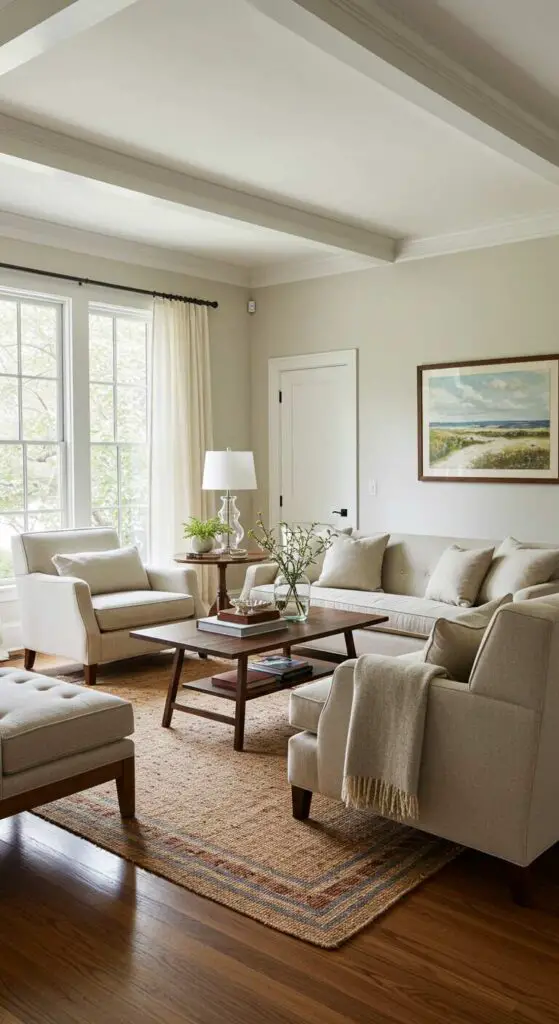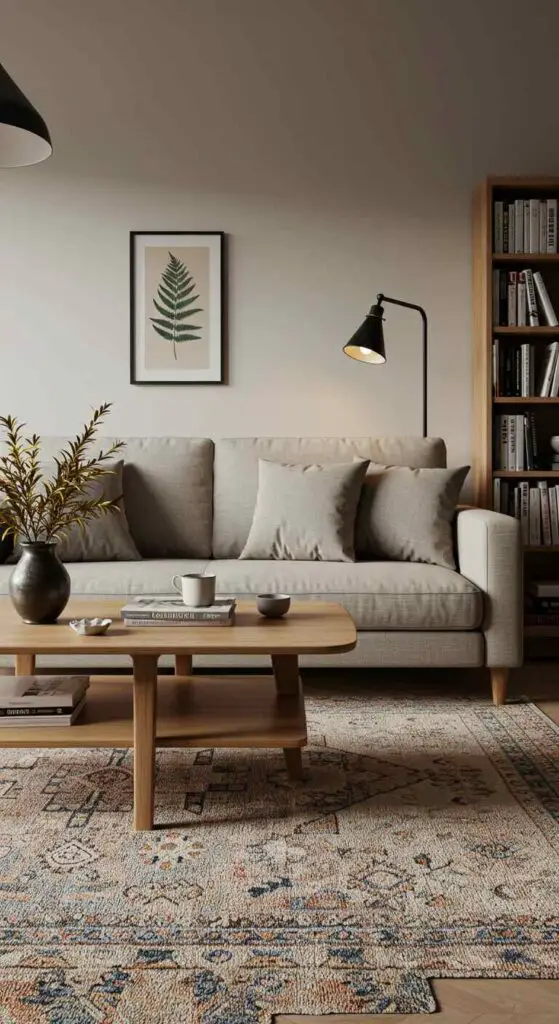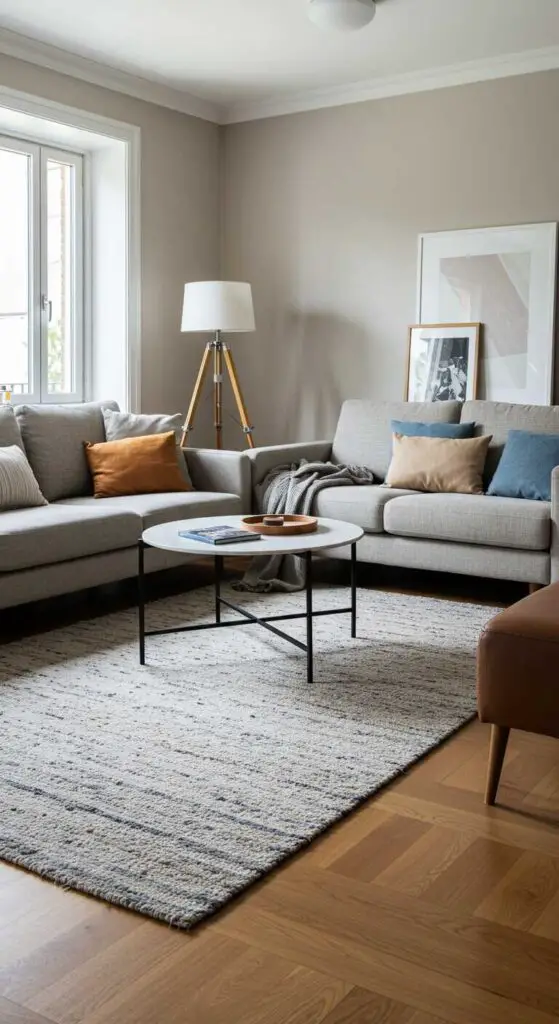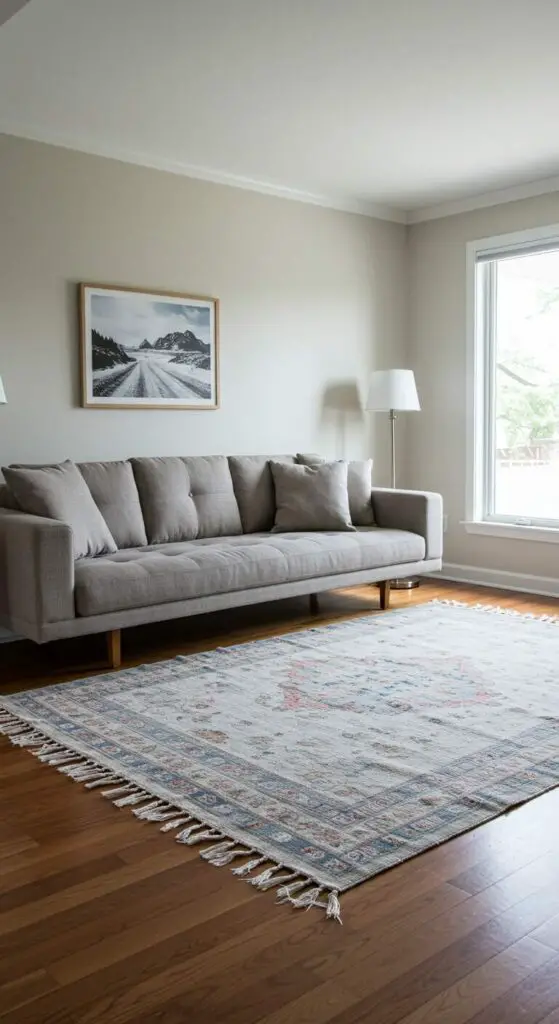A living room rug is more than just a decorative piece—it defines your space, adds warmth, and creates a sense of balance. The right rug placement can tie your furniture together, making the room feel cozy and well-arranged. Whether you have a large open-concept layout or a compact seating area, rug placement is key to achieving a stylish look.
From centering your rug under furniture to using layering techniques, there are many ways to place a rug for the best effect. A well-placed rug brings harmony to your living room, ensuring that the space feels cohesive and inviting. Choosing the right size and shape also plays a big role in how your rug enhances the overall decor.
We’ll explore different rug placement ideas that will help you create a visually appealing and well-balanced living room. No matter your style—modern, boho, or farmhouse—these ideas will help you achieve a polished and comfortable space.
1. Large Area Rug Anchoring All Furniture

A large area rug that accommodates all the furniture pieces in your living room creates a sense of unity. This layout works best in spacious rooms where the rug extends under the sofa, chairs, and coffee table. It defines the seating area while making the space feel more put together.
When choosing a rug for this style, make sure it extends at least 6-8 inches beyond the furniture legs. A neutral or textured rug works well in this placement, adding depth without overpowering the decor. Opt for a 9×12 or 10×14 rug for larger living rooms.
If your budget doesn’t allow for an oversized rug, try a room-sized rug that fits just under the front legs of furniture. This still creates a connected look while using a smaller (and more affordable) rug.
2. Front-Legs-On Rug Placement for a Casual Feel
For a more relaxed and budget-friendly look, place only the front legs of your sofa and chairs on the rug. This method helps create a cohesive feel while keeping some floor space exposed, which is ideal for small to medium-sized living rooms.
This placement works well with medium-sized rugs (such as 6×9 or 8×10 feet), making it a great option if you want to define your space without overwhelming it. Choose a patterned or textured rug to add visual interest while keeping the arrangement simple.
If you have a sectional sofa, this method helps frame the space without making it feel too heavy. A rectangular or oval rug works well for this layout.
3. Rug Centered Under the Coffee Table

A small or medium-sized rug centered under the coffee table is a great option for compact living rooms. This style keeps the rug as an accent piece rather than a full anchoring element.
To make this work, choose a rug that extends beyond the coffee table by at least 12-18 inches. This ensures the rug doesn’t feel too small or lost in the space. A round, oval, or square rug can add a unique touch to this setup.
This placement is especially effective in open-concept spaces where the rug helps define the seating area while allowing for more flexibility in furniture arrangement.
4. Layering Rugs for a Cozy Look
Layering rugs is a great way to add texture and dimension to your living room. Start with a large neutral rug (like jute or sisal) and layer a smaller patterned rug on top for a stylish contrast.
This technique works well for boho, farmhouse, or eclectic spaces where you want to mix textures and colors. It also allows you to use a smaller decorative rug while still covering a larger area.
For best results, ensure the top rug is at least two-thirds the size of the base rug. This creates a balanced look without making the smaller rug seem lost.
5. Centering a Rug in a Small Living Room

If you have a small living room, placing a rug directly in the center can make the space feel larger and more defined. Choose a 5×7 or 6×9 rug that fits well within the seating arrangement without extending too far beyond the furniture.
To maintain balance, keep at least 12 inches of floor space around the rug. This placement works well in apartments or cozy homes where you want to add warmth without overwhelming the room.
A neutral or light-colored rug helps create an airy feel, making the space look open and inviting.
6. Using a Round Rug for a Unique Touch
A round rug can soften a room and add visual interest, especially in living rooms with curved furniture or circular coffee tables. It’s also a great choice for small or oddly shaped spaces where a rectangular rug might not fit well.
To style a round rug, make sure it’s large enough to fit under key furniture pieces like the coffee table or part of the sofa. An 8-foot round rug is a versatile size that works well in most living rooms.
This style is ideal for creating a cozy conversation area, making it perfect for intimate seating arrangements.
7. Diagonal Rug Placement for a Dynamic Look

Placing a rug at an angle can add movement and make your living room feel more dynamic. This layout works well in open-concept spaces or asymmetrical rooms where traditional rug placement doesn’t feel right.
To keep it balanced, position the rug so it still connects with the furniture while allowing parts of the floor to peek through. This technique works best with bold or patterned rugs that stand out.
8. Placing a Rug Under a Sectional Sofa
A sectional sofa requires a carefully placed rug to ensure the space feels grounded. The best option is to choose a rug large enough to extend beyond the front legs of the sectional while still framing the seating area.
An 8×10 or 9×12 rug typically works well, depending on the size of your sectional. If your space is large, consider extending the rug beyond the coffee table for a cohesive look.
9. Rug Under a Floating Sofa

If your sofa is placed in the middle of the room (rather than against a wall), a rug can help anchor the furniture and create a defined seating zone. Choose a rug large enough to fit under the sofa and coffee table to maintain balance.
This placement works especially well in open-concept living spaces where the rug helps separate different functional areas.
10. Small Accent Rugs for a Cozy Touch
Adding small accent rugs in specific areas—like next to a chair, under a side table, or in front of a fireplace—creates warmth without covering too much floor space.
Choose rugs with soft textures, like faux fur or woven cotton, to enhance coziness. This works well in reading nooks or cozy corners of the living room.
11. Extra Large Rugs for Open Floor Plans

For large open-concept living rooms, an extra-large rug (such as 10×14 or 12×15 feet) helps define the space. This ensures that all furniture pieces feel connected rather than scattered.
A low-pile or flat-weave rug works best for this setup, as it provides comfort without overwhelming the space.
12. Rugs with Bold Patterns for a Statement Look
A bold-patterned rug can serve as the focal point of your living room. Choose stripes, geometric prints, or traditional Persian rugs to add depth and personality.
Pair it with neutral furniture to maintain balance and prevent visual clutter.
13. High-Pile Rugs for a Luxurious Feel

A high-pile rug (like a shag or wool rug) adds warmth and comfort, making your living room feel extra cozy. These work best in formal or relaxing lounge areas rather than high-traffic zones.
Choose a soft, neutral tone to create an inviting atmosphere while keeping the look elegant.
Final Thoughts
The right rug placement can transform your living room, making it feel balanced, cozy, and stylish. Whether you prefer classic layouts, layering techniques, or bold statement pieces, these ideas will help you create the perfect setup for your home.
